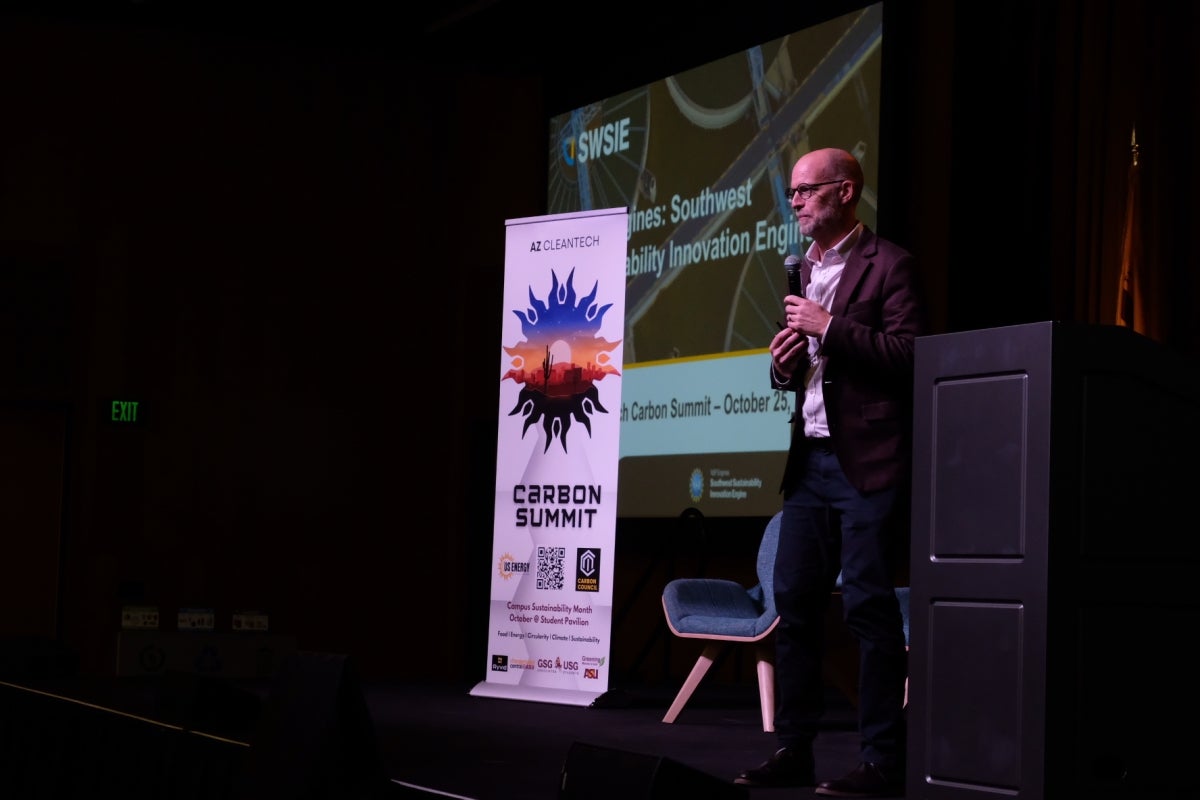ASU Carbon Summit displays sustainability leadership, collaboration and ... electric motorcycles

Jon Unangst (left), director of global government and business development for electric vehicle company Ryvid, speaks with aerospace engineering student Adam Drew (right) and psychology student Preston Mackey (center). Ryvid displayed electric motorcycles outside of the Student Pavilion for the Carbon Summit event Oct. 24–25. Photo by Katelyn Reinhart
This month, a student-led initiative brought government officials, entrepreneurs and nongovernmental organizations under one roof to discuss sustainable carbon solutions.
The annual Carbon Summit — the second of its kind at Arizona State University — took place from Oct. 24–25 at the Student Pavilion.
Speakers at the event presented on a variety of carbon-related themes: food transitions, energy transitions, circular economies, climate adaptation and sustainability.
Jason Marmon, a graduate student who served as the event director of the Carbon Summit, said this year’s event was a demonstration of the collaboration needed to tackle some of the most pressing challenges of our time.
“We're finding common ground for common good,” said Marmon, who is pursuing concurrent master's degrees in entrepreneurship and innovation through the W. P. Carey School of Business and in sustainability solutions through the College of Global Futures. “We need to have consensus on priorities for society and for communities. … We need to put our differences aside and focus on what we can agree on.”
The event was led by the Carbon Council, a student organization. Partners included AZ CleanTech, Undergraduate Student Government, Graduate Student Government, Changemaker Central and University Sustainability Practices. The two-day carbon solution showcase included speeches, presentations and pitches from a wide range of leaders both in and outside of ASU.
One ASU-focused presentation featured insights from Marc Campbell, assistant vice president of sustainability at ASU, on the university’s goal of being fully sustainable.
One challenge of being a “fully sustainable university,” Campbell said, is first defining what that means. Repeatedly ranked No. 1 for its sustainability impact and home to the world’s first School of Sustainability, ASU’s commitment to sustainability is well documented. But there is much to be done, he said, and the work should encompass the entirety of the ASU experience.
“I can sit in my office and come up with a definition of a ‘fully sustainable university.’ I can come up with revised goals,” he said. “But this isn't about me, and this isn't about my office. This is about all of us. This is about our institution and what we want to see it become.”
Campbell’s presentation highlighted a recurring theme of the Carbon Summit presentations: Decarbonization across all sectors will take years of determined, focused and mindful efforts. However, the individuals dedicated to the work being presented — including ASU students who worked to organize the summit — did not seem discouraged by the scale of the task.
Sandra Perez, a junior studying material science and engineering in the Ira A. Fulton Schools of Engineering, is the co-founder and current president of the Carbon Council. The Carbon Council is a student organization dedicated to accelerating climate change solutions. The student group’s primary events, the Carbon Summit and an Earth Day concert, aim to encourage student and professional engagement in the sustainability space.
“There are so many students across all these different ASU schools who have the same passion for sustainability,” Perez said. “In sustainability, we need to be multidisciplinary and have interdisciplinary collaboration. The purpose of the Carbon Council is to unite every student, regardless of their major or education level.”
Perez worked closely with Marmon and other event organizers leading up to the Carbon Summit. She said that, as a student, it was inspiring to work directly with university entities and sustainability leaders.
“There are a lot of students out there who have very big visions for the future, but they feel like they have to wait to work toward them until it’s the ‘right time’ or until they’re ‘fully qualified’ to do so,” Perez said. “That’s simply not true. There are people out there who want you to get involved and want to help you. You just need to start.”
Miss this year's Carbon Summit? Watch it online.
The Carbon Summit was recorded and can be viewed online. The first video in the series can be found here.
More Environment and sustainability

10 climate insights to guide our future
A group of globally renowned social, natural and climate scientists has once again convened to offer their newest annual synthesis report, “10 New Insights in Climate Science.”The report, published…

The future is green: Job demand translates to high employability for ASU sustainability grads
A 2023 report by Forbes on the state of green jobs confirmed what Arizona State University has been trumpeting for years: Sustainability will play a large part in the new economy.The report suggests…

Researcher works on changing people's mindsets to fight climate change
Meaningful action to heal the climate requires a complete shift in the way people think and perceive each other, according to an expert on social transformation who spoke at Arizona State University…


